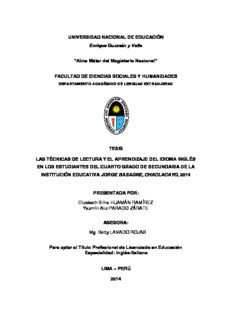Table Of ContentUNIVERSIDAD NACIONAL DE EDUCACIÓN
Enrique Guzmán y Valle
“Alma Máter del Magisterio Nacional”
FACULTAD DE CIENCIAS SOCIALES Y HUMANIDADES
DEPARTAMENTO ACADÉMICO DE LENGUAS EXTRANJERAS
TESIS
LAS TÉCNICAS DE LECTURA Y EL APRENDIZAJE DEL IDIOMA INGLÉS
EN LOS ESTUDIANTES DEL CUARTO GRADO DE SECUNDARIA DE LA
INSTITUCIÓN EDUCATIVA JORGE BASADRE, CHACLACAYO, 2014
PRESENTADA POR:
Elizabeth Bilha HUAMÁN RAMÍREZ
Yazmín Aliz PARADO ZÁRATE
ASESORA:
Mg. Betty LAVADO ROJAS
Para optar al Título Profesional de Licenciado en Educación
Especialidad: Inglés-Italiano
LIMA – PERÚ
2014
UNIVERSIDAD NACIONAL DE EDUCACIÓN
Enrique Guzmán y Valle
“Alma Máter del Magisterio Nacional”
FACULTAD DE CIENCIAS SOCIALES Y HUMANIDADES
DEPARTAMENTO ACADÉMICO DE LENGUAS EXTRANJERAS
TESIS
LAS TÉCNICAS DE LECTURA Y EL APRENDIZAJE DEL IDIOMA INGLÉS
EN LOS ESTUDIANTES DEL CUARTO GRADO DE SECUNDARIA DE LA
INSTITUCIÓN EDUCATIVA JORGE BASADRE, CHACLACAYO, 2014
PRESENTADA POR:
Elizabeth Bilha HUAMÁN RAMÍREZ
Yazmín Aliz PARADO ZÁRATE
ASESORA:
Mg. Betty LAVADO ROJAS
Para optar al Título Profesional de Licenciado en Educación
Especialidad: Inglés-Italiano
LIMA – PERÚ
2014
A nuestros padres, por el apoyo
brindado y, a nuestra asesora, por
habernos transmitido conocimientos
y llevado paso a paso en el
aprendizaje.
v
RESUMEN
El presente trabajo de investigación tiene como objetivo establecer el grado de
relación entre las técnicas de lectura y el aprendizaje del idioma inglés en los
estudiantes del cuarto grado de secundaria de la Institución Educativa Jorge
Basadre, Chaclacayo, 2014. Este trabajo es sustantivo, descriptivo y
correlacional. La muestra censal fue de 53 estudiantes, de los cuales se
recogió la información a través de un cuestionario con respuestas del tipo
escala de Likert, además del test en el área de Inglés para el registro de
información sobre su aprendizaje en las dimensiones de comprensión y
producción de textos. Como conclusión, los resultados obtenidos permiten
afirmar que las técnicas de lectura se relacionan significativamente con el
aprendizaje del idioma inglés.
Palabras clave: técnicas de lectura, aprendizaje, comprensión de textos,
producción de textos, anticipación.
vi
ABSTRACT
This research has the objective to establish the degree of relationship between
reading techniques and English language learning in the fourth year students of
Secondary Educational Institution Jorge Basadre, Chaclacayo, 2014.
Methodologically, this work is of type substantive, descriptive and correlational
design method. The census sample was 53 students, of which the information
was collected through a questionnaire responses type Likert scale, as well as
the test in the area of English, for recording information about their learning in
the dimensions of written texts comprehension and production. In conclusion,
the obtained results allow arguing that reading techniques are significantly
related to the English language learning.
Keywords: reading techniques, learning, written texts comprehension and
production, anticipation.
vii
ÍNDICE
Pág.
Dedicatoria .........................................................................................................................v
Resumen........................................................................................................................... vi
Abstract ............................................................................................................................ vii
Índice............................................................................................................................... viii
Introducción ..................................................................................................................... xii
PRIMERA PARTE: ASPECTOS TEÓRICOS
CAPÍTULO I: MARCO TEÓRICO
1.1. ANTECEDENTES DEL PROBLEMA....................................................................15
1.1.1. Antecedentes internacionales .......................................................................15
1.1.2. Antecedentes nacionales ..............................................................................17
1.2. BASES TEÓRICAS ...............................................................................................18
Subcapítulo I: Las técnicas de lectura.................................................................18
1.2.1. La lectura .........................................................................................................18
1.2.2. Definición de técnicas de lectura ....................................................................20
1.2.2.1. Técnicas antes de la lectura..................................................................21
A. Revisión previa..................................................................................22
B. Anticipación .......................................................................................24
1.2.2.2. Técnicas durante la lectura ...................................................................27
A. Scanning o técnica de lectura específica .........................................28
B. Skimming o tecnica de lectura selectiva ..........................................30
C. El subrayado .....................................................................................33
1.2.2.3. Técnicas después de la lectura .............................................................36
A. El mapa conceptual ..........................................................................36
B. Resumen ...........................................................................................40
C. Cuestionario ......................................................................................42
Subcapítulo II: El aprendizaje del idioma inglés..................................................44
1.2.3. Definiciones sobre aprendizaje.......................................................................44
1.2.4. El aprendizaje del idioma inglés .....................................................................46
1.2.5. Capacidades del área de Inglés según el DCN año 2009 .............................49
1.2.5.1. Expresión y comprensión oral ........................................................51
1.2.5.2. Comprensión de textos escritos.....................................................51
A. Concepto sobre el texto....................................................................54
B. Características del texto ...................................................................54
viii
C. Propiedades del texto .......................................................................55
D. Las ideas principales y secundarias de un texto .............................58
1.2.5.3. Producción de textos escritos ........................................................62
a. La planificación ................................................................................63
b. La textualización ...............................................................................64
c. La revisión.........................................................................................66
1.3. DEFINICIÓN DE TÉRMINOS BÁSICOS ..............................................................67
CAPÍTULO II: PLANTEAMIENTO DEL PROBLEMA
2.1. DETERMINACIÓN DEL PROBLEMA...................................................................69
2.2. FORMULACIÓN DEL PROBLEMA ......................................................................70
2.2.1. Problema general ..........................................................................................70
2.2.2. Problema específico ......................................................................................71
2.3. OBJETIVOS ..........................................................................................................71
2.3.1. Objetivo general.............................................................................................71
2.3.2. Objetivos específicos.....................................................................................72
2.4. IMPORTANCIA Y ALCANCES DE LA INVESTIGACIÓN ....................................72
2.5. LIMITACIONES DE LA INVESTIGACIÓN............................................................73
CAPÍTULO III: DE LA METODOLOGÍA
3.1. SISTEMA DE HIPÓTESIS Y VARIABLES ...........................................................75
3.1.1. Hipótesis general ...........................................................................................75
3.1.2. Hipótesis específicas .....................................................................................75
3.1.3. Variables ........................................................................................................76
3.1.3.1. Dimensión operacional de las variables................................................76
3.2. TIPO Y MÉTODO DE LA INVESTIGACIÓN ........................................................76
3.2.1. Tipo de la investigación .................................................................................77
3.3. DISEÑO DE LA INVESTIGACIÓN ......................................................................77
3.4. INSTRUMENTOS DE LA INVESTIGACIÓN ........................................................79
3.5. TÉCNICAS DE RECOLECCIÓN DE DATOS.......................................................79
3.6. POBLACIÓN Y MUESTRA ...................................................................................80
3.6.1. Población .......................................................................................................80
3.6.2. Muestra ..........................................................................................................81
ix
SEGUNDA PARTE: DEL TRABAJO DE CAMPO O ASPECTOS PRÁCTICOS
CAPÍTULO IV: DE LOS RESULTADOS
4.1. SELECCIÓN Y VALIDACIÓN DE LOS INSTRUMENTOS ..................................83
4.1.1. Selección de los instrumentos......................................................................83
4.1.2. Validación de los instrumentos utilizados ....................................................84
4.2. CONFIABILIDAD DE LOS INSTRUMENTOS ......................................................85
4.3. TRATAMIENTO ESTADÍSTICO E INTERPRETACIÓN DE DATOS ..................86
4.4. DISCUSIÓN DE RESULTADOS ........................................................................104
CONCLUSIONES ..........................................................................................................107
RECOMENDACIONES .................................................................................................108
REFERENCIAS ............................................................................................................109
ANEXOS ........................................................................................................................115
x
Description:aircraft, but will man ever be able to build flying machines? Maybe they will fly very low and very short .. El aprendizaje tiene una importancia fundamental para el hombre, ya que, cuando nace, se halla .. Earth, intelligent forms of life turned off the electrical fluent at 20.30 past meridian for

